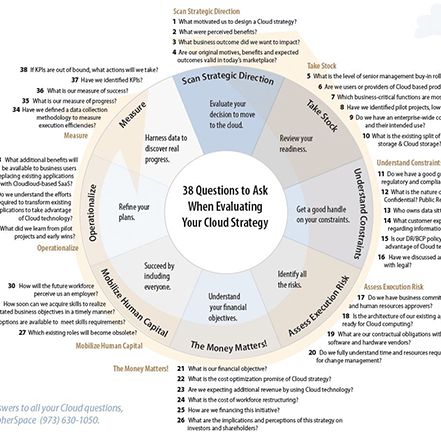What Questions To Ask To Avoid The Risk Of Failure Of Your Cloud Strategy
It was a coffee table conversation time at Olympus Caffe and Bakery in downtown Mountain View. I was there to help a friend prepare for an upcoming interview at valley’s newly crowned unicorn (Let’s call this company ‘X’). He was given a case study and was asked to present his views about the case as part of interviewing process. During prep work, my friend quoted one of his interviewers (paraphrasing) “Our software is not easy to configure. So-called configuration changes require custom coding, resulting in delays leading to customer satisfaction issues”. This intrigued me greatly; we were talking about a “born in the cloud” business with billion dollar valuation. How did they end up in this state?
Company X’, in B2B space is enjoying mega success in the niche they have carved out – kudos to them! But, today, I urge you, the decision maker, to take a pause, and put yourself in the shoes of the customer who has made product offering from ‘X’, integral to their cloud-first initiative. You should be asking, are we deriving the promised benefit from our cloud strategy in a timely manner?

Whether you are part of the majority who has started the journey into adopting cloud technology or are still sitting on the fence, you have most certainly considered the breadth and depth of impact, cloud technology can have on your future business. Consider, once again, the ‘X’ case, they certainly needed a relook at their software architecture and move to cloud-centric design. As a provider or as a user of a cloud-based product, it is essential that you put into practice ‘build – measure – learn’ loop and do a periodic evaluation of your cloud strategy.
Here is a list of some simple but searching questions, which you must ask while evaluating cloud strategy.
Your aspiration: Evaluate the effectiveness of cloud strategy in achieving desired business benefits.
1 Scan Strategic Direction
- What motivated us to design a cloud strategy?
- What were perceived benefits?
- What business outcome did we want to impact?
- Are our original motives, benefits and expected outcomes valid in today’s marketplace?
In answering these questions, you are firmly grounding your thought-process to why your business chose to invest time and resources in this initiative and re-affirming validity of your strategic direction.
2 Take Stock
- What is the level of senior management buy-in in rolling-out cloud strategy?
- Are we users or providers of cloud-based products and services?
- Which business-critical functions are most ready to take advantage of cloud-based existence?
- Have we identified pilot projects, low-hanging fruits, and early wins?
- Do we have an enterprise-wide consolidated list of applications and their intended usage in place?
- What is the existing split of data between on-premise storage & cloud storage?
You are assessing your readiness. If you have answers to all of the above questions then, it’s awesome! You have hit the ground running. Return to these questions in future iterations because rapid advances in technology might make previous answers obsolete.
3 Understand Constraints
- Do we have a good grasp on our business’ regulatory and compliance obligations?
- What is the nature of information stored by us? Confidential? Public Records? Sensitive?
- Who owns data sitting on our servers?
- What customer expectations have been set regarding information security?
- Is our DR/BCP policy geared to take advantage of cloud technology?
- Have we discussed and cleared our plan with legal?
You are putting your arms around organizational boundaries within which you are operating. These are tough questions, with multifaceted answers. Many of them will begin with, “it depends!” Having a good handle on answers would help you prioritize your execution backlog.
4 Assess Execution Risk
- Do we have business commit from approvers of financial and human resources?
- Are our existing applications architecture-wise ready to take advantage of cloud computing?
- What are our contractual obligations with existing software and hardware vendors?
- Do we fully understand time and resources required for change management?
The goal is to preempt every perceived risk and have a mitigation plan. This is a continuous exercise; risks will change with every phase of execution and will demand a lot from your creative problem-solving skills.
5 The Money Matters!
- What is our financial objective?
- What is the cost optimization promise for a cloud strategy?
- Are we expecting additional revenue by leveraging cloud technologies?
- What is the cost of workforce restructuring?
- How are we financing this initiative?
- What are the implications and likely perceptions of this strategy on investors and shareholders?
The powers-that-be understand this language and so must you. You are making decisions about decommissioning of existing assets, re-purposing available resources, re-negotiating contracts, cloud vendors selection, and skills acquisition. In short, justifying and defending your budget asks and earning some brownie points while you are at it! Be thorough in answering these questions.
6 Mobilize Human Capital
- Which existing roles will become obsolete?
- What options are available to meet skills requirements?
- How soon can we acquire skills to realize stated business objectives in a timely manner?
- How will the future workforce perceive us as an employer?
Understanding and addressing the anxieties of existing human capital goes a long way toward a successful cloud strategy. Throughout your cloud transformation process, you will need to strike the right skill balance by training in-house talent, leveraging vendor’s resources and ramping up hiring to keep up the pace. Answering the above questions will help in making informed decisions.
7 Operationalize
- What did we learn from pilot projects and early wins?
- Do we understand the efforts required to transform existing applications to leverage advantages offered by cloud technology?
- What additional benefits will be available to business users by replacing existing applications with cloud-based SaaS?
“…plans are useless, but planning is indispensable” – agile movement has popularized this quote from Eisenhower. More often than not, you will be deviating from plans; but answers to these questions will come in handy during next phase planning. It will help in making adjustments leading to next round of business benefits.
8 Measure
- Have we defined data collection methodology to measure execution efficiencies?
- What is our measure of progress?
- What is our measure of success?
- Have we identified KPIs?

The effectiveness of a strategy can be measured by scrutinizing its use of allocated resources and its ability to achieve desired outcomes. Having an underlying framework for data collection, KPIs, and measurement tools, both qualitative and quantitative are essential to show success and ensure continued support for your strategy. You will need to answer the above questions in order to arrive at the measurement framework.
CipherSpace offers Strategic Consulting to formulate, evaluate, and optimize cloud adoption for businesses.
Download this blog as a PDF
Illustration image source: A whatsapp forward!